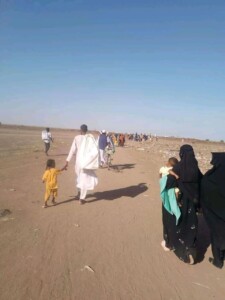‘8% of Sudanese population displaced or refugees’ – UNHCR report
A report by the UN refugee agency (UNHCR) published today shows that with over a million refugees, Sudan ranks sixth among host countries worldwide, while in Africa, Sudan is the number two host country. It also puts Sudan among the top 10 countries with internal displacement.
 El Nimir refugee camp in East Darfur (File photo: UNHCR)
El Nimir refugee camp in East Darfur (File photo: UNHCR)
A report by the UN refugee agency (UNHCR) published today shows that with over a million refugees, Sudan ranks sixth among host countries worldwide, while in Africa, Sudan is the number two host country. It also puts Sudan among the top 10 countries with internal displacement.
UNHCR’s annual Global Trends report, which comes two days ahead of 20 June World Refugee Day, shows that an unprecedented 79.5 million were displaced as of the end of 2019. UNHCR has not seen a higher total.
The report says that forced displacement is now affecting more than one per cent of humanity – 1 in every 97 people – with fewer and fewer of those who flee being able to return home.
The UNHCR is today appealing to countries worldwide to do far more to find homes for millions of refugees and others displaced by conflict, persecution, or events seriously disturbing public order.
In Africa, only Uganda was home to more refugees than Sudan at the end of 2019. Turkey, Colombia, and Pakistan are found on top of the global table.
‘We need a fundamentally new and more accepting attitude towards all who flee…’ – UN High Commissioner for Refugees Filippo Grandi
The report also illustrates the need for resolving displacement for nearly 735,000 Sudanese who live as refugees abroad, mainly in the region.
“We need a fundamentally new and more accepting attitude towards all who flee, coupled with a much more determined drive to unlock conflicts that go on for years and that are at the root of such immense suffering,” said UN High Commissioner for Refugees Filippo Grandi when presenting the UNHCR’s annual Global Trends.
The report shows that of the 79.5 million who were displaced at the end of last year, 45.7 million were people who had fled to other areas of their own countries, including 1.8 million Sudanese which puts the country among the top ten countries with internal displacement. Together with Sudan’s refugees, they represent over 8 percent of the entire population.
The rest were people displaced elsewhere, 4.2 million of them being people awaiting the outcome of asylum requests, while 29.6 million were refugees (26 million) and others forcibly displaced outside their country.
“The annual increase, from a figure of 70.8 million at the end of 2018, is a result of two main factors. First is worrying new displacement in 2019, particularly in Democratic Republic of the Congo, the Sahel, Yemen and Syria – the latter now in its ninth year of conflict and accounting on its own for 13.2 million refugees, asylum seekers, and internally displaced people, fully a sixth of the world’s total,” the report states.
Second is a better presentation of the situation of Venezuelans outside their country, many of whom are not legally registered as refugees or asylum-seekers, the UNHCR report concludes.
Major challenge
As previously reported by Radio Dabanga, Sudan’s Prime Minister Abdallah Hamdok said, in an interview with Sudan National TV Channel on June 4, that addressing the issues of displaced people and refugees are the major challenges for the transitional government.
The PM said that his government had a peace framework in place before the current peace talks began. He added that this peace framework aimed to address the root causes of the conflict in the country. “The framework includes various issues such as transitional justice, good governance, and social development,” PM said. He explained that “if we could address the root causes, we would put an end to the vicious cycle of conflict and violence in the country”.
Forced displacement today (Source: UNHCR)
- 100 million people at least were forced to flee their homes in the past decade, seeking refugee either in or outside their countries. That’s more people fleeing than the entire population of Egypt, the world’s 14th most populous country.
- Forced displacement has almost doubled since 2010 (41 million then vs 79.5 million now).
- 80 per cent of the world’s displaced people are in countries or territories affected by acute food insecurity and malnutrition – many of them countries facing climate and other disaster risk.
- More than three-quarters of the world’s refugees (77 per cent) are caught up in situations of long-term displacement – for example the situation in Afghanistan, now in its fifth decade.
- More than eight of every 10 refugees (85 per cent) are in developing countries, generally a country neighbouring the one they fled.
- Five countries account for two-thirds of people displaced across borders: Syria, Venezuela, Afghanistan, South Sudan and Myanmar.
- Global Trends Report counts all major displaced and refugee populations, including the 5.6 million Palestine refugees who fall under the care of the United Nations Relief and Works Agency for Palestine.
- The 2030 Sustainable Development commitment of “leaving no one behind” now explicitly includes refugees, thanks to a new indicator on refugees approved by the UN Statistical Commission in March this year.
Note:
UNHCR’s Global Trends report is released in parallel with its annual Global Report, which reports on actions UNHCR is taking to address the needs of all who are forced to flee, as well as the world’s known stateless populations.
Radio Dabanga’s editorial independence means that we can continue to provide factual updates about political developments to Sudanese and international actors, educate people about how to avoid outbreaks of infectious diseases, and provide a window to the world for those in all corners of Sudan. Support Radio Dabanga for as little as €2.50, the equivalent of a cup of coffee.












 and then
and then